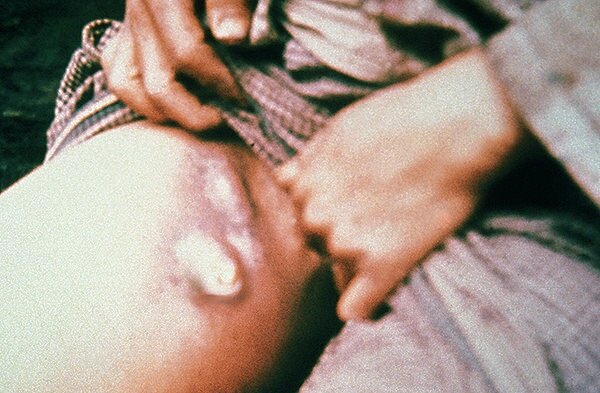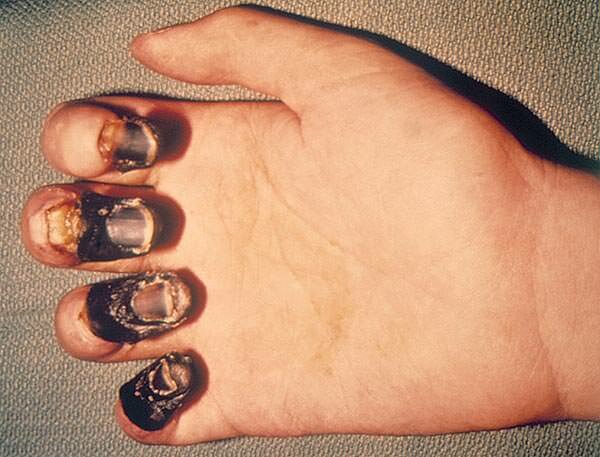“As large as a common apple…”
There are a number of different types of the plague. Each affects victims in different ways and causes death at different speeds. Read on for the signs and symptoms of the Black Death – bubonic, pneumonic, and septicemic plague.

Above: A plague patient showing a bubo caused by a swollen, ruptured inguinal lymph node (Image courtesy of Public Health Image Library, Centers for Disease Control and Prevention).
3 – the number of different types of the plague – bubonic, pneumonic, and septicemic.
All medical advice and attention was useless; the Tartars died as soon as the signs of disease appeared on their bodies: swellings in the armpit or groin caused by coagulating humours, followed by a putrid fever. – Gabriele de’ Mussis (c. 1280 – c. 1356), describing the symptoms experienced by one group of plague victims.
Types of Plague
Bubonic – spread by fleas, this was the most common form of the plague. Victims would have their lymph glands (found in the groin or armpits) swell up to form buboes.
Pneumonic – spread by coughing, directly from person-to-person, this was the most infectious form of the plague, and would affect the lungs.
Septicemic – also spread by fleas, this was the rarest form of the plague, and would infect the bloodstream, killing those affected within hours.
…with them died everyone who had talked to them. Anyone who touched or laid hands on their belongings died too. – Friar Michele (from Messina).
Did You Know?
Ibn al-Khatib, an Arab doctor, was one of the only people to recognise that plague was passed through contagion. He also recognised that the pneumonic form spread faster than the bubonic.
Bubonic Plague
2–8 days – the period over which the bubonic plague bacillus incubates, following a bite from a carrier flea.
2–6 – the number of days after infection that swelling occurs in the lymph glands nearest the bite (in the groin, armpits, or the neck), to form a bubo. These are extremely painful. Beforehand, victims will exhibit other symptoms: extreme lethargy, a high fever, vomiting, headaches, dizziness, pain in the limbs, stomach area and back, sensitivity to light, insomnia and severe diarrhea.
105°F – the typical temperature of the fever sufferers develop.
1 – the number of buboes victims of bubonic plague typically developed.
Did You Know?
Death from bubonic plague was typically due to extreme exhaustion, internal bleeding or heart failure.
1 week – the period within which, if the bubo splits, recovery will usually occur.
…as large as a common apple, others as an egg. – the Italian poet Giovanni Boccaccio (1313-1375), describing the size to which buboes could swell.
70-75% – the death rate from bubonic plague during the Black Death.
8–10 days – the typical period after which recovery comes. Should an individual recover they develop immunity against further outbreaks.
60% – the average mortality rate of bubonic plague today, if left untreated.
16% – the death rate from modern cases of bubonic plague, survival rates being much improved by modern medicine.
Did You Know?
Buboes can emit strange gurgling noises.
Pneumonic Plague
In some cases the plague bacteria will reach the lungs, causing pneumonic plague. Pneumonic plague is the only type that can be passed directly between people, via bloody mucous which is spread through coughing, sneezing or even speaking. The other forms of plague depend upon a carrier insect, typically fleas, to pass on the bacteria.
Messengers drawing others to death… – Ibn Habib, Arab historian, describing victims (of pneumonic plague) in Cairo spitting blood.
3% – the approximate percentage of victims who develop pneumonic plague.
Did You Know?
Pneumonic plague is more prevalent in colder months of the year, the opposite of the bubonic form.
1–3 – the period within which death from pneumonic plague usually occurs. Victims fall into a coma, after the lungs have filled with fluid.
Did You Know?
Whereas bubonic plague leads to an increase in body temperature, the pneumonic form leads to a marked drop.
95–100% – the average mortality rate of pneumonic plague if left untreated.
Septicemic Plague
In some cases the plague bacteria can bypass the lymph nodes and enter the bloodstream, causing the much more serious form of septicemic plague. Victims can become extremely weak, suffer toxic shock, and bleed into the skin and organs.
100% – the death rate from septicemic plague (survival is extremely rare).
When one person lay sick in a house no one would come near. Even dear friends would hide themselves away weeping. The physician would not visit. – Gabriele de’ Mussis (c. 1280 – c. 1356), a notary from Piacenza, Italy.
Did You Know?
Buboes do not develop with septicemic plague, the plague kills so quickly that they do not have time to appear. The hands and feet of victims harden and turn black, a condition called acral necrosis.

Above: Acral necrosis (Image courtesy of Public Health Image Library, Centers for Disease Control and Prevention).
Did You Know?
Once septicemic plague develops, the blood stream is so infected that the bacillus can now be spread by the human flea, Pulex irritans (in the other forms of plague, bubonic and pneumonic, the host’s blood does not contain enough of the bacteria for a fatal dose to be passed on.
24 hours – the period within which death occurs following a bite, after the blood becomes infected. A widespread rash also develops.
Did You Know?
Because septicemic kills the host so quickly it is actually the least effective form of plague in spreading to others. As a result it is also extremely rare, albeit always fatal.
One man, wanting to make his will, died along with the notary, the priest who heard his confession, and the people summoned to witness the will, and they were all buried together on the following day. – Gabriele de Mussis (c. 1280 – c. 1356)